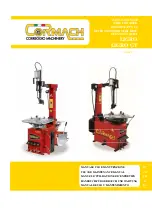
(8) Mounting
This information must be read and followed carefully to
prevent accidents and injuries during mounting.
Attempts to force a bead seat on mismatched tires and
wheels can cause the tire to violently explode, causing
serious personal injury or death to operator and/or
bystanders.
Check tire and wheel carefully before mounting. Make
sure the tire bead diameter and wheel diameter match
exactly. Consult the Tire Guide and/or Rubber Manu-
facturer's Association for approved rim widths for tire
sizes.
Never mount a damaged tire. Never mount a tire on a
rusty or damaged wheel. Damaged tires and/or wheels
may explode.
When in doubt do not mount
Never mount a tire and wheel handed to you by anyone
without checking both tire and wheel for damage and to
be certain the sizes match. Do not let untrained persons
operate tire changer and keep bystanders out of service
area.
Forcing the tire onto the rim can cause bead damage.
If you damage the tire bead during mounting, STOP!,
remove tire and mark it as damaged. Do not mount a
damaged tire.
1. Before any mounting, inspect tire for damage and
verify size match between tire and wheel (fig. 14).
Figure 14 - Verify Size Match Between Tire and Wheel
2. Inspect wheel closely for damage. Clean the
wheel and remove any light corrosion or rubber residue
(figure 15). Do not attempt to service a heavily corroded
wheel, damaged wheel, or bent wheel.
Figure 15 - Inspect and Clean the Wheel
3. Inspect valve stem and replace if necessary. Next
lubricate tire beads liberally with tire manufacturer’s
approved rubber lubricant (figure 16).
Figure 16 - Lubricate Tire Beads Liberally














